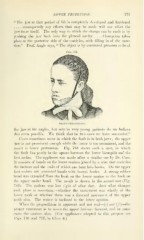Page 779 - My FlipBook
P. 779
LOWER PBOTRUSIOX. — 777
" The jaw at that period of life is completely developed and hardened
.... consequently any efforts that may be made will not affect the
jaw-bone itself. The only way in which the change can be made is by
pushing the jaw back into the glenoid cavity. . . . Absorption takes
place at the posterior side of the condyles, with filling in of the ante-
rior." Prof. Angle says, " The object is by continued pressure to bend
Fig. 784.
Angle's chin retractor.
the jaw at the angles, but only in very young patients do we believe
this even possible. We think that in two cases we have succeeded."
Ca.ses sometimes occur in which the fault is in both jaws ; the upper
jaw is not prominent enough while the lower is too prominent, and the
result is lower protrusion. Fig. 788 shows such a case, in which
the fault lies partly in the spaces between the lower bicuspids and the
first molar. The appliance was made after a similar one by Dr. Case.
It consists of bands on the loAver canines joined by a wire that encircles
the incisors and the ends of which are bent into hooks. On the upper
first molars are cemented bands with buccal hooks. A strong rubber
band was extended from the hook on the lower canine to the hook on
the upper molar band. The result is shown in the second cast (Fig.
789). The patient was lost sight of after that. Just what changes
took place is uncertain,—whether the movement was wholly of the
lower teeth or whether there Avas a forward movement of the upper
teeth also. The writer is inclined to the latter opinion.
AVhen the prognathism is apparent and not real (e) and (/)—the
proper treatment is to move the upper incisors forward, and in some
cases the canines also. (For appliances adapted to this purpose see
Figs. 716 and 717, in Class 6.)


